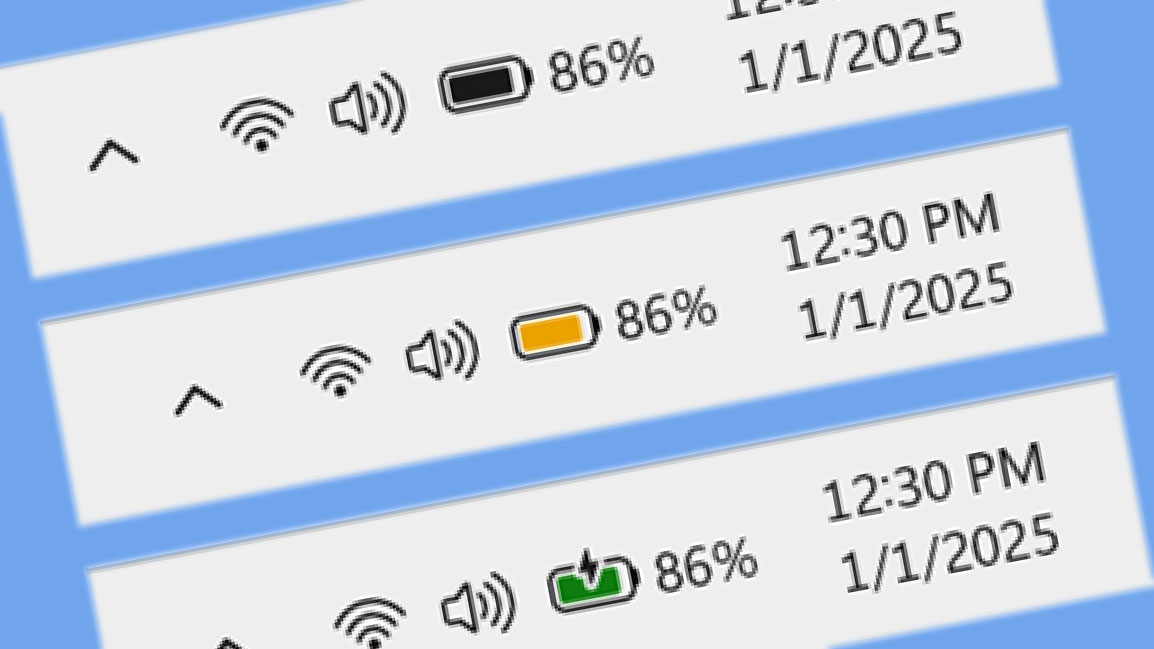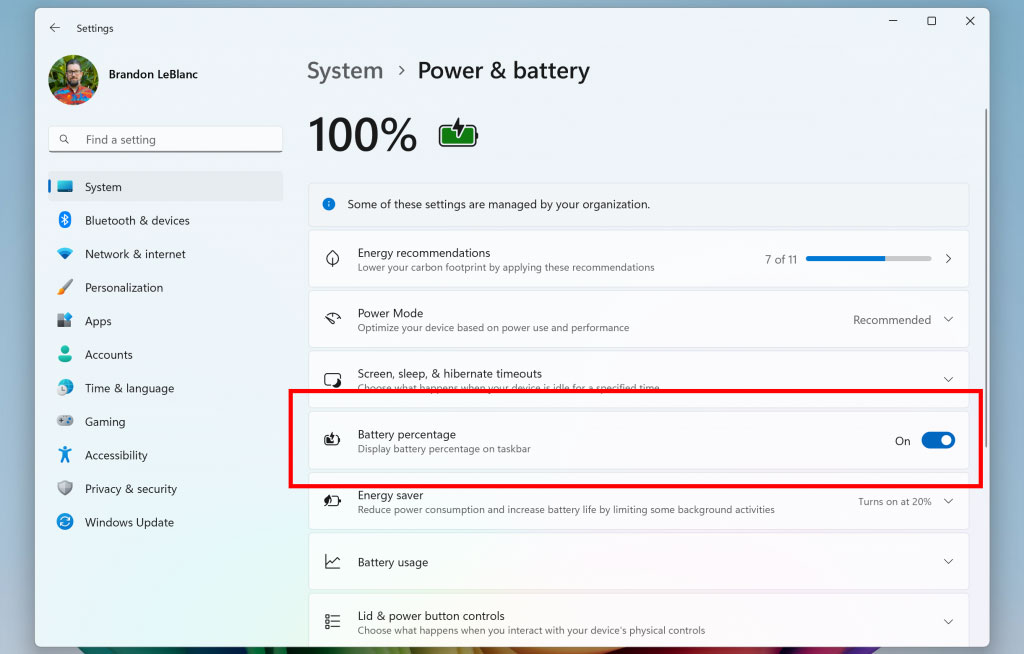Microsoft reveals improved Windows 11 battery icons and percentage toggle settings
Larger icons, more color, clearer information delivered at a glance.

Microsoft has officially revealed that it has been working on "improving the battery iconography in Windows 11." Thanks to a Windows enthusiast and data miner, we saw these changes in December 2024. However, Microsoft has fully revealed the key changes, explaining how to tweak the UI and toggle a battery percentage display in the taskbar.
Friday's Windows blog post discusses the taskbar battery icon changes. The post is timed to accompany the release of Windows 11 Insider Preview Build 26120.3000 (KB5050103) to the Dev Channel. Microsoft's battery icon redesign gets top billing.
To make the Windows 11 UI more intuitive, Microsoft has enabled color battery icons in the taskbar. Assuming normal color vision, the color changes should quickly confirm the battery's charging state with a sideways glance. So, what do all the colors mean? We've made a handy list below.
- Green: battery charging and in a good state
- Yellow: your PC using battery in energy-saving mode
- Red: you have a critically low battery and should seek a charger
- Black: Microsoft's blog doesn't explain it, but we will assume black means your PC is using battery and it hasn't drained enough to trigger energy saving mode or gone into critical low battery territory.
Microsoft notes that these new battery colors will be visible in the Windows 11 taskbar and the quick settings flyout and Settings. In a future update, Microsoft also wants the new icons on the Lock screen.
There are a couple of other Windows 11 battery icon changes worth highlighting. Firstly, Microsoft has decided to use a few more pixels to enhance the battery icon's glanceability.

Last but not least, in Settings, Windows 11 users can decide whether they want a battery percentage figure next to the icon. With the newest breed of energy-sipping laptops, perhaps some can banish their battery remaining anxiety and toggle the percentage indicator off.
Windows Insiders are also playing with a new Gamepad keyboard layout for the touch keyboard in Windows 11, new Narrator functions, and may be pleased with a quintet of Fire Explorer fixes. Lots and lots of known issues remain.
Get Tom's Hardware's best news and in-depth reviews, straight to your inbox.

Mark Tyson is a news editor at Tom's Hardware. He enjoys covering the full breadth of PC tech; from business and semiconductor design to products approaching the edge of reason.
-
emike09 What I'd like to see most is the ability to limit charge to 80% or 90%. This would require collaboration between the manufacturer, particularly between the firmware and the OS. After three years on my XPS 13 9310, the battery only has about 60% capacity. Fortunately, it's not too hard to replace the battery.Reply -
Alvar "Miles" Udell Typical Microsoft, do something that's probably #9000 on the list of requested features.Reply -
ezst036 ReplyAlvar Miles Udell said:Typical Microsoft, do something that's probably #9000 on the list of requested features.
That is actually not the worst of it. No person users requested Microsoft to embed advertisement displaying capability into Windows itself. Adware. Which necessarily has to have a spyware component to it.
Yet, they did it. In multiple places. So Microsoft has served Microsoft first, putting other more requested features on hold while they build in absolute junk only for the likes of Amazon or whoever they are selling this data to and displaying ads for. -
jkhoward Great, now bring back additional power options to the masses and let people adjust them (yes, I know how to do this).Reply -
svan71 Damn I dumped Windows over the data mining and the Recall but wow new battery icons SMH.Reply -
Mama Changa Reply
My old Dell XPS 15 from 2016 allows you to set % limits for when battery will start charging and stop charging. Mine won't charge until it's depleted to 50% and stops at 90%emike09 said:What I'd like to see most is the ability to limit charge to 80% or 90%. This would require collaboration between the manufacturer, particularly between the firmware and the OS. After three years on my XPS 13 9310, the battery only has about 60% capacity. Fortunately, it's not too hard to replace the battery. -
Feren Reply
Actually, lots of people (implicitly) requested this - shareholders.Alvar Miles Udell said:Typical Microsoft, do something that's probably #9000 on the list of requested features. -
OldAnalogWorld Reply
It's quite strange to hear something like this from the owner of the top Dell series, when even their gaming G series have long ago implemented full software control of charging directly from the BIOS and OS.emike09 said:What I'd like to see most is the ability to limit charge to 80% or 90%. This would require collaboration between the manufacturer, particularly between the firmware and the OS. After three years on my XPS 13 9310, the battery only has about 60% capacity. Fortunately, it's not too hard to replace the battery.
I own an old Dell G laptop and from the moment of purchase I simply set the mode to 100%->60%->100%. Battery wear (the laptop runs from the power supply 99.9% of the time) is 6% in 6+ years. Although it was of poor quality from the moment of purchase - it could spontaneously turn off the laptop under a load of 15-20% even with a charge of 70%. But I didn't even change it, because I didn't even think of using it from the battery.
The Thinkpad also has a programmable charging controller (and even auto-discharge with a shunt). But as my empirical experience has shown, the 80-55-80 mode is worse than 100-60-100, the wear in the first is much faster.
On the other hand, one of my oldest laptops - a "gaming" MSI from 2008 - came with a 9-cell battery, and this battery even after 16 years kept the laptop running for more than 45 minutes. At the same time, this laptop was always running from the power supply in the most hellish mode of 100%>95%>100%, since there was no way to reprogram the levels. And nevertheless, the battery survived 16 years, which means the cells there were of very high quality. For example, in the Thinkpad, the battery failed after 6.5 years, also in the 99% mode from the power supply, but with the levels specified above. I also noticed that in new laptop models, there is a gradual deterioration in the quality of batteries from the factory, precisely in the long term usage... -
emike09 Reply
Thanks for the reply, I learned a little more after digging around. On my XPS and Latitude systems, there isn't any BIOS option to set percentages for the battery. There is, however, options to specify how you use it, such as "Primarily AC". My understanding was that's how aggressive the system is charged. While that's true, it turns out it also caps the max charge to ~80% and modifies when charging starts again.OldAnalogWorld said:It's quite strange to hear something like this from the owner of the top Dell series, when even their gaming G series have long ago implemented full software control of charging directly from the BIOS and OS.
I own an old Dell G laptop and from the moment of purchase I simply set the mode to 100%->60%->100%. Battery wear (the laptop runs from the power supply 99.9% of the time) is 6% in 6+ years. Although it was of poor quality from the moment of purchase - it could spontaneously turn off the laptop under a load of 15-20% even with a charge of 70%. But I didn't even change it, because I didn't even think of using it from the battery.
The Thinkpad also has a programmable charging controller (and even auto-discharge with a shunt). But as my empirical experience has shown, the 80-55-80 mode is worse than 100-60-100, the wear in the first is much faster.
On the other hand, one of my oldest laptops - a "gaming" MSI from 2008 - came with a 9-cell battery, and this battery even after 16 years kept the laptop running for more than 45 minutes. At the same time, this laptop was always running from the power supply in the most hellish mode of 100%>95%>100%, since there was no way to reprogram the levels. And nevertheless, the battery survived 16 years, which means the cells there were of very high quality. For example, in the Thinkpad, the battery failed after 6.5 years, also in the 99% mode from the power supply, but with the levels specified above. I also noticed that in new laptop models, there is a gradual deterioration in the quality of batteries from the factory, precisely in the long term usage... -
OldAnalogWorld Replyemike09 said:While that's true, it turns out it also caps the max charge to ~80% and modifies when charging starts again.
What is important in your case is not the limitation threshold, but the self-discharge range, while the laptop is constantly running from the power supply. For example, Lenovo sets a 5% self-discharge range in its cheap series, after which charging begins, so there is no point in the (60%-55%-60%) scheme - the battery is still killed just as quickly as with the 100-95-100% scheme. And even worse, as I showed above. It is important that the self-discharge of the battery when running from the power supply is at least 20%. That is, if your upper threshold is 80%, then the lower one should not be higher than 60%. If it starts charging in the 80-75-80 scheme, it still kills the battery quite quickly and is even worse than 100-95-100.